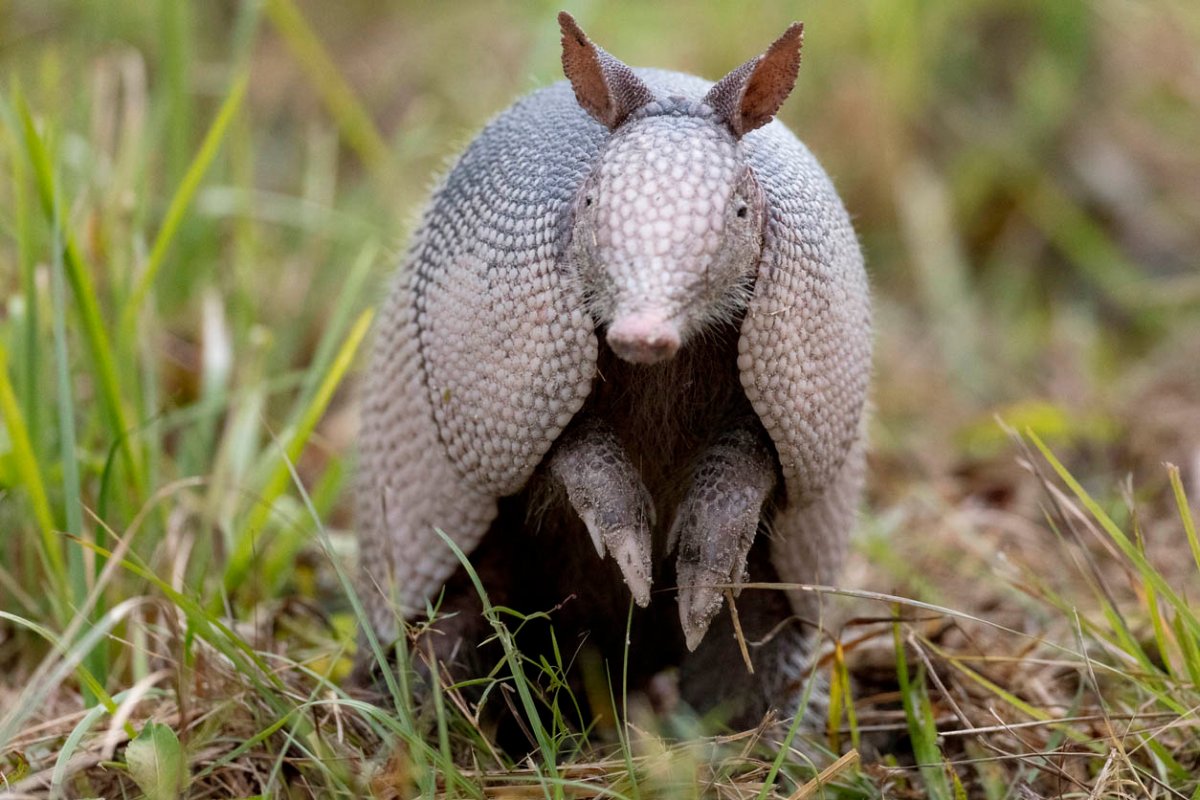

We may earn revenue from the products available on this page and participate in affiliate programs. Learn More ›
For homeowners living in the American Southwest, armadillos can be annoying pests with potentially devastating effects on lawn and vegetation. Armadillo means “little armored one” in Spanish, and it’s an apt name as the armadillo is the only mammal with a hard shell. Armadillos’ primary food sources consist of bugs, grubs, and worms. Armadillos can leave sizable (3-inch by 5-inch) divots in dirt or grass, and their burrows can grow up to 24 feet in length. Armadillos have the potential to wreak havoc on lawns, so it’s essential to know how to get rid of armadillos. However, if this proves too daunting or armadillos continue to be a problem, contact one of the best wildlife removal services, such as Critter Control or Trutech, to help humanely remove the animals from the property
Time required: 3-7 days
Difficulty: Beginner to Intermediate
Estimated cost: Technical removal starts at $150 but varies depending on job requirements; materials and preventative measures will vary.
Tools & Materials
Bobvila.com may earn a commission from purchases made through these links.
- Motion-activated water sprinkler
- Motion-sensing light
- Non-lethal armadillo trap, plus earthworms for bait
Before You Begin…
Armadillos can climb and dig well, so natural repellents may not help with long-term eradication.
Are armadillos dangerous? No, armadillos aren’t usually aggressive creatures. However, while sporadic, several cases of armadillo-borne leprosy (or Hansen’s disease) in humans have been reported. Ultimately, homeowners may wish to hire a professional to help control an armadillo infestation.
Tips for Getting Rid of Armadillos
- Above all else, armadillos care about their food source. Removing their food sources from your home or lawn can deter armadillos from entering your property.
- Armadillos are most active at night. Setting traps at armadillo holes or burrow entrances before dusk is most effective.
Safety Considerations
- Wear gloves or long pants if planning to touch or be within an arm’s length of an armadillo.
- Watch your step if walking near burrows and armadillo holes to avoid injury.
STEP 1: Identify the armadillos.
The first step in how to get rid of armadillos is identifying if the pest is an armadillo. More likely than not, the armadillo will be a nine-banded armadillo. The nine-banded armadillo is the only species of armadillo that has made its way into the United States from Latin America, where as many as 20 different species of armadillos live. While armadillos prefer warm habitats, some have been found as far north as Nebraska and Illinois.
Nine-banded armadillos have seven to 11 armor-like plates (or “bands”) on their body, are usually brownish-black or gray, and have tiny black eyes and a pointed snout. They weigh an average of 12 pounds and are about 2.5 to 4 feet long.
STEP 2: Locate any areas of damage around the property.
The best place to look for signs of armadillo burrows is around vegetation, including shrubs, bushes, trees, flower beds, and gardening plots. It’s also a good idea to check the home’s perimeter, as armadillos may burrow and create a nest around a house’s foundation.
While it might be tough to spot the animal (as they’re nocturnal), identifying where they’ve done damage may be easier. Armadillos dig up grass, turf, and plants in their search for food, so overturned dirt and soil can be a telling sign.

STEP 3: Remove attractants like fallen fruit, dense shrubbery, or brush piles.
Armadillos focus solely on their food sources, so taking that away can help deter armadillos from yards. Removing shrubs, bushes, tall grass, or other places where armadillos’ main food can live is a good starting point.
What do armadillos eat? Invertebrates like cockroaches, beetles, ants, termites, and other insects. While fruit makes up less than 10 percent of an armadillo’s diet, throwing away fallen fruit removes both insects that may be enjoying the fruit and a source of nutrients for the armadillo as well.
STEP 4: Install an in-ground fence.
Although armadillos climb well, installing an in-ground fence may be a solution for deterring armadillos from homes. To improve the fence’s effectiveness against armadillos, bury at least 12 inches of fence underground, then slant the fencing outward at a 40-degree angle and allow at least 24 inches of fencing above ground.
Because armadillos use their strong legs and front claws to dig, it’s crucial the fence is made of sturdy material and has no larger spaces for armadillos (or other creatures) to crawl through.
STEP 5: Try natural armadillo repellents like cayenne or garlic.
Armadillos make up for their poor eyesight with an incredible sense of smell. Pungent odors like garlic can disrupt armadillos’ ability to smell and might be unpleasant enough to deter them from your property. Try placing cloves of crushed garlic where you suspect armadillos are lurking.
Similar to garlic, cayenne pepper’s natural qualities may deter armadillos. Capsaicin, a chemical irritant found in cayenne peppers, can cause inflammation in animals’ stomachs if ingested. In addition to garlic, you can sprinkle cayenne powder near a potential food source. However, rain can easily wash away cayenne.
STEP 6: Use electronic deterrents to scare armadillos.
Electronic deterrents can be a great above-ground solution for scaring away armadillos. Motion-activated sprinklers and motion-sensing lights can be placed in hot spots like vegetable gardens and flower beds and frighten skittish armadillos.
STEP 7: Buy commercial armadillo repellent.
Commercial armadillo repellents use substances like castor oil to spoil an armadillo’s food source and create an unpleasant odor inside armadillo burrows. This choice is a humane, long-lasting underground solution for driving out an animal that relies heavily on smell and only cares about its next meal. Using this in conjunction with electronic deterrents can prevent armadillos from digging, driving them off properties, and keeping them away.

STEP 8: Set humane armadillo traps.
When repellents aren’t working or aren’t an option for hard-to-reach places, live traps can solve an armadillo problem. Because armadillos have poor eyesight, they rely on common pathways, which makes their behavior predictable. Place traps at night near burrow entrances or a wall close to the incurred damage. Furthermore, setting out dishes of earthworms where you plan to lay a trap a few nights before can make it easier to bait armadillos into the cage. Trapping can be tricky, and laws vary about trapping and relocating animals, so check with your local animal control branch or town and state legislature.
STEP 9: Contact a local pro.
The best and most reliable way to get rid of armadillos is to contact a local pest control company to customize a solution to your particular property. Not only are technicians trained to deal with various pests safely, but they may also be able to identify where the problem stems, fill in burrows, and deter other unwanted creatures from encroaching on the yard.
Nine-banded armadillos can damage lawns or gardens, so identifying burrows and signs of an unwelcome guest early are essential. Removing attractants like piles of brush, using commercial armadillo repellent, and setting up motion-activated electronic deterrents are a few ways to take away an armadillo’s reasons for coming up to a homeowner’s lawn. If all else fails, a local professional can help eliminate armadillos from a home and lawn.
